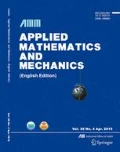Abstract
In this article, as the velocity gradient is taken as a constant value, we obtain the solutions of the equation of fluctuation velocity after Fourier transform. When the mean velocity gradient is small, they represent the picture of eddies, of which the homogeneous turbulence (both isotropic and nonisotropic) of the final period is composed. By using the eddies of these types at different times, we may compose the steady turbulent field with the constant velocity gradient and this field may represent the turbulent field in the central part of the channel flow or pipe flow approximately. Then we may obtain the double velocity correlation function of this turbulent field, which involves both longitudinal correlation coefficient\(f\left( {\frac{r}{\lambda }} \right)\) and the transversal correlation coefficient\(g\left( {\frac{r}{\lambda }} \right)\). We compare these theoretical coefficients with the experimental data of these coefficients at initial period and final period of isotropic homogeneous turbulence. And then we obtain the relationship between the turbulent double velocity correlation coefficient\(f\left( {\frac{r}{\lambda }} \right)\) and the mean velocity gradient. Finally, we get the expressions of the Reynolds stress and the eddy viscosity coefficient.
Similar content being viewed by others
References
Chou Pei-yuan and Tsai Shu-tang, The motion of spherical vortex in viscous fluid, Journal of Peking University (Natural Science), (1956), 39–51. (in Chinese)
Chou Pei-yuan and Tsai Shu-tang, The vorticity structure of homogeneous isotropic turbulence in its final period of decay, Chinese Journal of Mechanics, 1 No. 1, (1957), 3–14. (in Chinese)
Chou Pei-yuan and Huang Yong-nian, The statistical theory of homogeneous isotropic turbulence, Scientia Sinica, (1975), 180–198. (in Chinese)
Tsai Shu-tang and Mar Bai-kun, Vorticity structure of late stage uniform non-isotropic turbulence and comparison of experiment of J.C. Bennett with the experiment of S. Corrsin, Acta Mechanica Sinica, (1981), 1–10. (in Chinese)
Chou Pei-yian and Tsai Shu-tang, Final stage motion of free turbulence, Journal of Peking University (Natural Science), (1958), 405–414. (in Chinese)
Batchelor, G.K. and A.A. Townsend, Proc. Roy. Soc. Lond. A 193, (1948), 539–558.
Stewart, R.W. and A.A. Townsend, Phil. Trans. Roy. Soc. Lond. A. 243, (1951), 359–386.
Gortler, H., Zeit. f. ang. Math. u. Mech. 22 (1942), 244–254.
Chang Kuo-fan, Chinese Journal of Physics, 7 (1948), 176–191. (in Chinese)
Hu Nig, Chinese Journal of Physics, 5 (1944), 1–29. (in Chinese)
Laufer, J., Natl. Advisory Comm. Aeronaut. Tech. Repts., No. 1174, (1954).
Author information
Authors and Affiliations
Rights and permissions
About this article
Cite this article
Shu-tang, T. The double velocity correlation function of homogeneous turbulence with constant mean velocity gradient. Appl Math Mech 4, 681–697 (1983). https://doi.org/10.1007/BF02432080
Received:
Issue Date:
DOI: https://doi.org/10.1007/BF02432080




